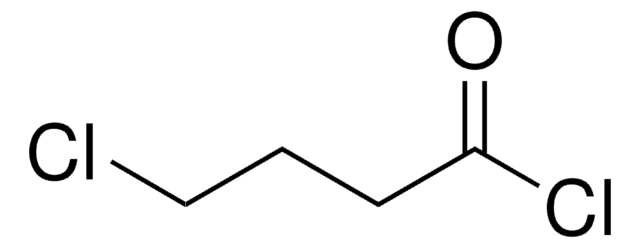563919
Aluminum chloride
anhydrous, powder, 99.999% trace metals basis
Synonyme(s) :
Aluminium trichloride, Aluminum(III) chloride, Trichloroaluminum
About This Item
Produits recommandés
Qualité
anhydrous
Pression de vapeur
1 mmHg ( 100 °C)
Pureté
99.999% trace metals basis
Forme
powder
Pertinence de la réaction
reagent type: catalyst
core: aluminum
Impuretés
≤15.0 ppm Trace Metal Analysis
Pf
190 °C (lit.)
Chaîne SMILES
Cl[Al](Cl)Cl
InChI
1S/Al.3ClH/h;3*1H/q+3;;;/p-3
Clé InChI
VSCWAEJMTAWNJL-UHFFFAOYSA-K
Vous recherchez des produits similaires ? Visite Guide de comparaison des produits
Description générale
Application
- To prepare cost-effective ionic liquid electrolyte for high performance aluminum ion battery.
- To fabricate modified SnO2 triple layered photoanode for dye sensitized solar cells. This leads to suppression of electron recombination and five-fold enhancement of efficiency.
- As a precursor to synthesize CsPbCl3 perovskite nanocrystals for bright white light-emitting diodes. It improves photoluminescence quantum yield.
Caractéristiques et avantages
- High purity with trace metal analysis (=< 15 ppm) makes suitable for batteries.
- High water solubility
- Stable under battery operation conditions
À utiliser avec
Mention d'avertissement
Danger
Mentions de danger
Classification des risques
Eye Dam. 1 - Skin Corr. 1B
Risques supp
Code de la classe de stockage
8B - Non-combustible corrosive hazardous materials
Classe de danger pour l'eau (WGK)
WGK 1
Point d'éclair (°F)
Not applicable
Point d'éclair (°C)
Not applicable
Équipement de protection individuelle
Eyeshields, Faceshields, Gloves, type P3 (EN 143) respirator cartridges
Faites votre choix parmi les versions les plus récentes :
Déjà en possession de ce produit ?
Retrouvez la documentation relative aux produits que vous avez récemment achetés dans la Bibliothèque de documents.
Les clients ont également consulté
Articles
White solid-state light can be generated using three different approaches: By employing three diodes that emit red, green and blue light respectively, by using a near-UV LED that excites several phosphors that emit over the complete spectral range, or the third, most widely used alternative entailing down-conversion of a portion of blue LED light to longer wavelengths in such a manner that white light emerges.
Contenu apparenté
We offer a complete line of the highest purity inorganic salts and materials for the micro and nanoelectronics market.
Notre équipe de scientifiques dispose d'une expérience dans tous les secteurs de la recherche, notamment en sciences de la vie, science des matériaux, synthèse chimique, chromatographie, analyse et dans de nombreux autres domaines..
Contacter notre Service technique





